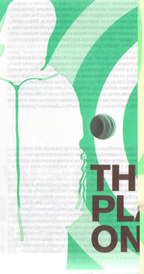:: Monday, January 10, 2005 ::
 NEW.WRTING: THE SUBLIMNINAL KID AL RITMO DELLA SCIENZA
NEW.WRTING: THE SUBLIMNINAL KID AL RITMO DELLA SCIENZA
BY: Francesca De Nicolò
Rhythm science è un minimale testo-oggetto, raccolta di scritti con connesso cd (mediawork pamplet concettuale ) che ci apre la porta del mondo di Paul Miller aka DJ Spooky . Un luogo dove Miller teorizza scrive un manifesto e mette in fila tutte le sue citazioni e maestri che vanno da Du Bois a Gilles Deleuze al Wu-Tan Clan. Qui Spooky narra della sua infanzia a Washington D.C. dove nato nel distretto conosceva il mondo attraverso la radio, la radio che saltava le stazioni che lo crescevano e gli instillavano questo gusto per il copia e incolla che attraversa com’è noto tutta la cultura del dj postmoderno artista d’oggi .
Ascoltava sia i Kraftwerk che gli Afrika bambaata e al tempo stesso assisteva all’ascesa delle Black Panther, con conoscenza di Malcom X e Angela Davis. Anche i Fugazi affascinano l’infante Spooky, come tutta la letteratura cyber punk più avanti, e come ovviamente Marcel Duchamp. Ci scrive a caratteri cubitali che ha deciso di diventare un’artista, uno scrittore e che si è trasferito a NY, volendo vivere quell’atmosfera dove tutto sembra possibile, come lui scrive.
Nel 1999 realizza un cd con Scanner, un lavoro dove Scanner voleva fare “la critica dell’impossibile”, così il suo lavoro scivola nella filosofia e Spooky diventa anche un teorico della possibilità infinita d’interazione con la macchina. Parla ancora nel suo testo della possibilità di creare una dj culture, che sia una possibilità di moltiplicazione tecnologica, non c’è più una sola personalità ovvero americani, africani, irlandesi, ebrei, in una interconnessione usando un termine di moda molto “melting pop”. Il riitmo della scienza è così generato dalla possibilità totale di dividere il file nel mondo e creare quindi milioni di persone che avranno milioni di moltitudini di possibilità di creare nuove forme. Hip hop è sempre innovativo e crea una quantità e una moltitudine di cose che diventano un’applicazione che è Darwinismo sociale seguendo sempre il pensiero di Miller, trattasi quindi della realizzazione di un modello cooperativo di un’ informazioni e di contaminazioni che generano il sempre più nuovo. Un modo sempre più nuovo che potrebbe essere anche pericoloso, a dire di Spooky e che da antropologo contemporaneo ama guardare da fuori, quale amante anche della storia. Ma Spooky va ancora più in là e cerca di guardare ancora a cosa è per lui il ritmo della scienza, ritmo che intende perseguire in tutte le sue miriadi di manifestazioni.
E così inizia a snodare i binari della storia qui definitivamente capitolata per ritrovare a suo dire il ritmo della scienza e bisogna rievocare il 1875 dieci anni dopo la guerra civile che aveva demolito metà degli stati Uniti quando il poeta Ralph Waldo Emerson che Spooky esalta quale “ Quotation and Originality”.
Due anni dopo 1877 Thomas Edison inventò qualcosa di nuovo che portò a qualcosa che assomiglia all’attuale mix , il fonografo dando luogo all’evoluzione del ritmo della scienza. Spooky nel suo testo parla anche non a caso di Gianbattista Vico e di Donald Philip Verene riferendosi alla Nuova scienza come al teatro della memoria. Teatro della memoria che per Miller è molto importante, come testimoniano tutti i suoi lavori. Ritmo della scienza è quindi come Miller ancora sostiene, il soggetto in sincronizzazione, un qualcosa che quindi definitivamente allinea la problematica soggetto oggetto di cartesiana memoria. E così Miller continua ad attraversare il cinema ritmico, arrivando poi ad Errata Erratum, un’ interessante disquisizione sul suo lavoro su Marcel Duchamp, composta nel 1913, collage composer , al quale ha dedicato un interessante lavoro, com’è noto, per poi arrivare ad affermare tra le pagine del suo libro che : il Futuro è ora. Cita infatti William Gibson e dichiara di essere felice di essere nato in questa era, un’era che gli permette di viaggiare e di essere manipolato e risputato da continui mondi.
Infine Miller parla in un capitolo della prostituzione e della metafora semplice con quella che è la nostra posizione della vita attuale, ogni volta lui dice che usasiamo la rete è come se andassimo con una prostituta alla quale succhiamo energie e che si vende a tutti e trasformandoci ogni singola volta clicchiamo sul mouse per prendere la connessione; introducendo in questo modo uno sguardo carnale nel contatto con un mondo dello della net molto spesso visto con freddo cinismo da formalina.
Con ultima scoccata Miller si dilegua e dichiara sarcasticamente che pensare è illegale.
Uno splendido cd è connesso al lavoro, multiforme miscela musicale, che attraversa, il dub, il jazz, i canti africani e l’ambient elettronico, le voci fuori campo dei comizi e tanto altro ennesimo simbolo della memoria organica. Ed ecco qui Rhythm science, disegnato per definire la massima visibilità e seduzione tattile dallo studio internazionale COMA.
 ORIGINAL POST: Saturday, January 08, 2005
ORIGINAL POST: Saturday, January 08, 2005BY: Eduardo Navas
Review of MTAA's 1 Year Performance Video (samHsieHupdate)
Duchamp is often cited as the predecessor to conceptual art, mainly because of his famous urinal, which questions the autonomy and materiality of the work of art. However, a direct and even open attack on the materiality, autonomy and (later added) marketability of the art object did not happen until the emergence of Conceptual Art in the 1970s. Much of the work at this time relied on critiquing the object's relation to the white cube (the gallery), or the institutions that supported the supposed autonomy of the art object. Michael Asher and Hans Haacke are textbook examples of this practice.
After this period artists began to comment on other artists more specifically. Janine Antoni's work is one of the many examples of this allegorization, as well as Sherrie Levine's which relies on appropriation as a way to critique works by famous male artists, including Duchamp. Since then there have been a great number of other artists who have used such a strategy to comment on the multi-layered contentions of the object art. And this short but well-established practice has been extended to the web with works like MTAA's 1 Year Performance Video (samHsieHupdate).
In this web-piece, the artists update the work of Tehching Hsieh, in particular his "One Year Performance 1978-1979," where Hsieh spent a whole year in a cell. He did not leave the space. A person brought him food and took away his refuse. The piece was notarized by a lawyer to give it authenticity.
T. Whid and M. River, who collaborate under the name of MTAA (M.River & T.Whid Art Associates) have extended Hsieh's concept of committing to an activity for one year on to the web by presenting themselves in a room apparently spending time alone in 1 Year Performance Video (samHsieHupdate). At first glance this mimics Hsieh's activities in the cell, as the artists appear juxtaposed in two video feeds, doing simple things that always correspond with the time of day when the internet user is accessing the website. In reality the artists prerecorded their activities and created computer files which now can be accessed according to the internet user's computer clock.
In this piece the visitors are encouraged to watch the video files for the period of one year, and to sign up for an online account in order to keep track of their time. The visitors do not have to be logged on for the whole time at once, and can leave and comeback according to their personal schedules.
While the online piece may allegorize Hsieh's performance, it does so in a very unexpected way. Particularly, it exposes the drastic changes in art production since Hsieh developed his one-year performances (He did a few of them). At the time that Hsieh was performing, the object of art was in question, and like conceptual art, performance art was a way to negotiate meaning as a cultural product (these movements obviously overlap).
While Hsieh's art practice is often considered in relation to art's role in culture, one thing that is not discussed about him is his particular position as an artist, dare I say a privileged one at that. Meaning that while he always did intensive performative pieces for one year, he had to be able to not work for that time in order to spend it making art. This position is of course at play if the artist's work in the studio is not considered work by the rest of culture, which is true in the United States. It is safe to say that Hsieh was interested in making the futile labor of art more obvious by creating pieces that led to no particular ends in themselves, but that instead ended up exposing the banality of the everyday, as well as the incidentally of art making in contemporary culture. Hence, his position not to hold a "real" job is important to note here.
This commitment and most importantly cultural position are passed on to the online user in MTAA's update. Here, the user quickly realizes that one year is a serious commitment that the average person is most likely unable to perform; thus Hsieh's particular role as an artist is exposed and questioned not passively but actively, because the users are given the option to put in their own time at anytime. The users then need to decide why they would commit to an online activity, especially when this activity will in the end validate the artists who were commissioned the project in the first place. This inversion, this transparency that is pivotal to the online project exposes the role of the audience in any work of art. In Hsieh's projects this is not so obvious because he is doing all the work, and all the viewer needs to do is acknowledge the final product through documentation.
1 Year Performance Video (samHsieHupdate), however, demands that the users acknowledge the work of art by completing it themselves, by actually putting in the time while watching pre-recorded files, the strain of the performance is on the viewer now, not the artist; but this strain is a virtual one, one that is no longer concerned with the body but with the dematerialization of such into a new type of action--a meta-action-- in art making, and art viewing. In a way, this not only updates the passive demand that a work of art has always had on the viewer: that it be completed by the viewer's gaze, but it also makes obvious the interactive demand of any art object since minimal art emerged. Michael Fried's opposition to the demand by the minimal object to have its meaning completed by the interaction of the viewer inside the gallery as a sort of theater is exposed in MTAA's update as a fascist imposition by a certain privileged culture, which can only be possible today with new technologies. Furthermore, the imposition is efficient and liberal because the users do not need to strain themselves on performing for one year at once. They can do it whenever is convenient for them, by logging on as they so desire. And they do not need to be present as they can leave their computers running, logging time while they do other things around the house. The performance update, then, becomes background noise, like Television in the average home.
An air of helplessness overpowering disinterestedness may be sensed at this point--one that involves those who sense it as well as those who have allegorically produced it.